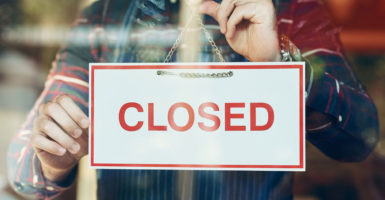In America, everyone who can is expected to work. We don’t think of work as some kind of punishment but as an element of a meaningful and productive life.
This goes for janitors, fast-food workers, and laborers, as well as lawyers, doctors, and chief executives. We all have a role to play, and we all have different opportunities to contribute.
But what happens when government erects barriers to work? And what happens when those barriers are completely artificial? The result is fewer jobs, according to a new study from the Wisconsin Institute for Law & Liberty on the burdens of occupational licensing in all 50 states.
Licensing laws, or government permission slips to work, require a prospective worker to accomplish minimum training requirements, pass exams, meet age and grade requirements, and pay fees to the state.
For individuals who have chosen to pursue a career in certain regulated professions, state governments from sea to shining sea have created a complex patchwork of these permission slips for individuals to work as cosmetologists, massage therapists, aestheticians, and hundreds of more low- and moderate-income jobs.
According to the Council of State Governments, more than 1,100 occupations are licensed in at least one state, but fewer than 60 are licensed in all 50. And recent estimates suggest between 1 in 4 and 1 in 3 workers in the United States today are required to earn a license. This is up from 1 in 20 in 1950.
What’s more, licensing laws are far from uniform. Each state determines the accompanying regulations and requirements, which more often than not, differ from state to state.
The result is a broad and unreasonable red tape spectrum.
For example, a cosmetologist license in New York requires 1,000 hours of training. In Wisconsin, a prospective cosmetologist is required to obtain 1,550 hours.
On the West Coast, in Oregon, cosmetologists are required to obtain 2,300 hours of training—a difference of seven additional months compared to their East Coast counterparts in New York.
One might wonder if there are any quantifiable differences between cosmetologists in Oregon as opposed to New York. Are haircuts safer in Oregon? Or better quality?
According to a 2016 study commissioned by the Professional Beauty Association—which advocates licensing—there was no relationship between a state’s minimum curriculum hours and safety incidents. What the Professional Beauty Association did find was a “strong negative and significant relationship between the total number of curriculum hours and employment rates.”
The Wisconsin Institute for Law & Liberty’s recent study, “Land of the Free?,” expanded on this research to determine how the inconsistent tapestry of licensing regulations impact employment for 10 different professions.
Using publicly available data from the Institute for Justice and the Bureau of Labor Statistics, the Wisconsin Institute’s econometric analysis found that states with burdensome licensing laws (high curriculum hours, fees, exams, etc.) had lower employment in the professions under study. Those professions included cosmetologists, aestheticians, athletic trainers, pest control workers, massage therapists, locksmiths, manicurists, emergency medical technicians, and veterinary technicians.
The five states that were the most heavily regulated, and paying the price in fewer jobs, were Tennessee, Alabama, Nevada, Florida, and Wisconsin. A full 23 states could see employment growth of between 5 percent and 9 percent across the 10 professions if they simply reduced their licensure regulations to those of the least burdensome state—Hawaii.
Moreover, employment nationwide, across the 10 professions, could increase by 4.5 percent if licensing regulations were reduced to the level of Hawaii.
Reforming licensure laws is no small undertaking. Special interests who benefit from burdensome licensing laws are adept at applying strong pressure on lawmakers and scaring the public about the potential threats to health and safety.
But reform is underway. Arizona and Mississippi passed major licensing reforms in 2017 that curb the power of licensing boards and set the stage for major challenges to the licensing regime. Maryland, Nebraska, and Tennessee have passed bills that create exemptions and limited licenses for blow-out salons, shampooers, and hair braiders.
Michigan and Delaware have created review commissions to evaluate the merits of licenses on the books, and Indiana is experimenting with an alternative to licensure called voluntary self-certification. And legislators in states like Wisconsin, Nevada, and Florida are pushing for reform with varying degrees of success.
At the federal level, licensing reform has earned bipartisan approval. Presidents Barack Obama and Donald Trump both identified licensing laws as a barrier to opportunity. Acting Federal Trade Commission Chair Maureen K. Ohlhausen, elevated by Trump and appointed by Obama, has made licensing reform a priority for the agency.
And on Capitol Hill, legislation has been introduced to encourage states to rein in licensing boards, incentivize states to explore alternatives to strict licensing laws through workforce training funds, and exploring licensing reform in the places Congress does have jurisdiction—the National Mall, national parks, and battlefields—in hopes that it could serve as a model for the states.
While debates rage about the best way to grow jobs and boost the economy, most agree that increasing access to opportunity ought to be a central goal. And while taxes and spending will typically be at the forefront of those debates, occupational licensing reform represents a significant way for members of both parties to increase opportunity.
And it won’t cost a dime. It simply requires the foresight and fortitude to examine how government is preventing and hindering everyday Americans from pursuing work.




























